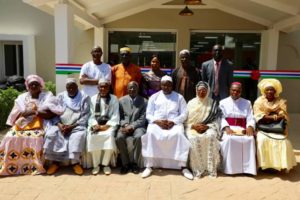via HNMCP blog
by Oladeji Tiamiyu ’20

President Adama Barrow of The Gambia takes a group picture with Truth, Reconciliation, and Reparations Commission (TRRC) members
In recent months, America has experienced significant social upheaval, ranging from the nation-wide protests in the aftermath of the killing of George Floyd to the attempted insurrection of the Capitol that led to the deaths of 5 individuals. In July 2020, Boston, San Francisco, and Philadelphia established truth commissions in an attempt to respond to the nation’s focus on systemic inequality. The events at the Capitol on January 6—and the discord that has marked the broader political and social dialogue since well before the election—highlight the important role that these types of structural interventions can play in promoting reconciliation. Looking outside of the United States, there are many examples of these institutions being implemented following regional and national crises. From Guatemala to South Korea and, most recently, The Gambia, truth commissions have been created to address harms ranging from genocide, to civil war, to extrajudicial killings. Perhaps most noteworthy is the use of a truth commission in post-Apartheid South Africa in response to a regime that effectively legalized systemic racism politically and economically. This blog post first provides an overview of truth commissions, particularly the two tools that are common to all commissions. Second, considering that truth commissions have been applied to such a broad scope of crises internationally, attention is given to their role in response to the particular circumstances of America’s ongoing crisis. The last section compares the system design of the three city commissions and identifies factors that can threaten the commissions’ success.
The dual mandate of truth commissions
Truth commissions have been used as one method for addressing crises that impair the relationship between different communities. At a minimum, truth commissions have a dual mandate to investigate events of a crisis in order to ascertain potential factors that contributed to the crisis while implementing mechanisms to reconcile different communities.
In seeking to ascertain the truth, sufficient funding is a critical piece of the puzzle. For instance, although the system design of Sierra Leone’s truth commission had positive elements, insufficient funding from the government limited the commission’s ability to conduct hearings throughout the country, raising doubts about the effectiveness of the process. In an era where social media platforms are used to advance inaccurate information, having sufficient funding to properly ascertain the truth is all the more important.
The second prong of the dual mandate is to create and implement mechanisms to reconcile communities over the long-term. Rather than relying solely on engaging harmed individuals, this prong also relies on active engagement with civil society organizations in order to dispel the concern that government actors contributing to the crisis are now seeking to create a superficial veil of reconciliation. One of the principal challenges the Haitian truth commission experienced in 1995 was that different civil society organizations did not properly participate in reconciliation initiatives. This lack of participation would prove to be a pivotal stumbling block.
Satisfying this dual mandate can be difficult: truth commissions may be confronted with the concern that investigating factors that contributed to the crisis will undermine initiatives to promote reconciliation. In practice, this concern is illusory. Reconciliation cannot be reached in the absence of understanding and communication; neither understanding nor effective communication can be achieved without accurately ascertaining the truth. Rather than ignoring the truth, investigating the truth and addressing related pain and suffering is fundamental for groups and communities to collectively heal and determine what their future relationships should be. Moreover, within an international law framework, the State has a duty to investigate those events and circumstances that contributed to human rights violations.
The value of truth commissions in the American context
Social unrest over the past eight months has left communities divided and has highlighted the justified distrust that some Americans have of state institutions. Yet despite these issues, the healthy skeptic may still ponder whether truth commissions can be effectively applied in America. After all, issues related to policing, the criminal justice system, and economic inequality are not new. From the healthy skeptic’s perspective, even though the present situation in America involves considerable dissatisfaction and raises systemic concerns, it is not to the same level as a civil war or genocide.
What this perspective misses is that truth commissions are not restricted to addressing only the most extreme human rights abuses. Rather, the fact that these commissions have been used to strengthen trust across different stakeholder groups following human rights abuses shows the broad scope of their applicability. Indeed, the very purpose of a truth commission is to address issues that appear intractable, particularly when there is distrust of government institutions and distrust between different communities. Similar to America, post-Apartheid South Africa used a truth commission in a coordinated effort to promote reconciliation and reduce the likelihood that state actors would continue to perpetrate harm against the populace. As communities throughout America continue to experience distrust of certain state actors, particularly law enforcement, truth commissions can play a role in engaging with the community to explore ways of promoting trust with these state actors.
The apparent coordinated effort from the three aforementioned cities to respond to systemic issues in a restorative manner provides a stark difference to the historical reliance on adverse litigation. Litigation has been ineffective at bringing communities together and providing clarity to marginalized groups, particularly given that often state actors receive sovereign immunity and harmed parties are unable to coordinate their initiatives. In this context, litigation operates as a zero-sum solution that increases the likelihood of distrust and misunderstanding between opposing parties without addressing the needs of communities. In contrast, a truth commission provides space to focus on the system causing the unrest while looking prospectively for opportunities to promote trust and understanding. Because the issues at the center of America’s present crisis are systemic, a process able to take a systems-based approach is best situated to promote reconciliation. Previously, truth commissions have effectively facilitated healing between communities divided during the Rwandan genocide and have promoted reconciliation between Peruvian communities that suffered human rights abuses under Alberto Fujimori’s administration.
The state of the three recently created truth commissions
The initiatives in Boston, San Francisco, and Philadelphia are an implicit recognition that the historical approach to addressing racial inequity has proven insufficient in helping communities. Indeed, the initiative of these commissions is part of a larger alternative dispute resolution movement that takes “a comprehensive, systems approach to the prevention, management, and resolution of conflict.” In recognizing that racial injustice impacts broad swaths of the nation and that litigation has significant limitations, these cities are attempting to provide their communities with a long term solution that promotes reconciliation.
While recognizing their potential, one must also recognize that the amount of funding a truth commission receives heavily influences their success. Simple budget items such as hiring a robust staff in addition to more complex factors, such as facilitating community hearings, all depend on substantial financial commitment. A prerequisite to being optimistic for a truth commission’s success is whether the commission has the funding to fulfill the dual mandate. Moreover, one could say that funding has symbolic importance in showing the commitment state actors have for the commission. Presently, the funding of the commissions leaves much to be desired. Each commission’s primary funding comes from the city district attorney’s office. Also providing fundraising support is the Grassroots Law Project, headed by Shaun King who has come under scrutiny for prior fundraising initiatives that resulted in organizations never receiving funds. Considering these commissions are still in an early stage and the Biden Administration has placed an emphasis on reconciliation initiatives, federal funding could benefit these commissions. Moreover, the funding of the commissions should be more transparent—currently, there is a dearth of public information disclosing how much of the district attorney’s budget will be allocated to the commission.
Because the initiative is led by each city’s district attorney, it is likely that the focus will prioritize changes that can be made within the criminal justice system, as opposed to addressing other systemic issues such as education and economic opportunities that are beyond the purview of the criminal justice system. Yet this narrower approach need not delegitimize the initiative. As San Francisco District Attorney Chesa Boudin stated, “prosecutors have a special responsibility to promote justice and reconciliation with the communities whose needs have historically been neglected.” With the level of influence district attorneys have, this may allow for significant change within the criminal justice system based on the findings of the truth commissions. Yet having a truth commission focus primarily on the criminal justice system comes with important trade-offs. The international approach to truth commissions has been to have commissioners who represent different facets of the country, including academics, civil society leaders, and religious leaders. A broader range of stakeholders represented allows these commissions to take a holistic approach; the American truth commissions’ reliance on district attorneys may struggle to cultivate something comparably broad. In addition, decentralized leadership allows for different facets of the community to feel represented in order to strengthen institutional legitimacy. Given that part of the American crisis stems from distrust of the criminal justice system, the district attorneys’ status as chief prosecutors creates heightened legitimacy concerns so the commissions will need to take greater initiative to build trust with skeptical communities.
These commissions remain in their design phase.1 For instance, Philadelphia’s commission is currently receiving input from various local communities to craft a statement of intent. This statement will hopefully determine the scope of the commission’s work, set forth certain criteria for determining what success would look like, and strengthen institutional legitimacy. Boston’s commission has expressed interest in going as far back as 1989 to investigate events related to Charles Stuart, who murdered his wife and blamed her death on a Black man. Meanwhile, the stated purpose of San Francisco’s truth commission has been focused on the police, including enacting policies “that hold police accountable” and “build truth with those . . . . hurt by the lack of police accountability.”
Though the common theme is a focus on the criminal justice system, these statements also suggest that each commission will have slightly different scopes that could result in the creation of different mechanisms to ascertain the truth and reconcile communities. For instance, Boston’s interests in investigating specific crimes committed by non-state actors is likely to have greater engagement between different communities that deal with racial biases and less of an emphasis on systemic change from local government institutions. In contrast, we should expect that San Francisco’s focus on police accountability will require a greater degree of engagement with law enforcement and policy proposals that impact institutional actors.
It is a fundamental principle in designing dispute systems that the design and resulting processes of an institution will influence the substantive outcome of a dispute system. As these truth commissions are exploring their scope and design while other cities explore the benefits of creating similar commissions, the hope is for sustained political and social commitment to these initiatives with a willingness to innovate based on the unique conditions of each city.
[1] Between the creation of these commissions and this writing, the commissions have provided limited updates to the public. As such, it is difficult to distill where in the design phase the commissions are and the timeline for when the design phase will end and when implementation will begin.

Oladeji Tiamiyu is a Clinical Fellow at the Harvard Negotiation and Mediation Clinical Program. In 2019, he worked with The Gambia’s Truth and Reconciliation Commission. Read more about Oladeji here.
Filed in: Clinical Voices
Tags: Class of 2020, Harvard Negotiation & Mediation Clinical Program, HNMCP, Oladeji Tiamiyu
Contact Office of Clinical and Pro Bono Programs
Website:
hls.harvard.edu/clinics
Email:
clinical@law.harvard.edu